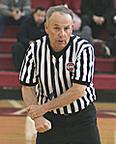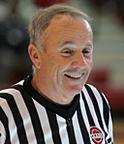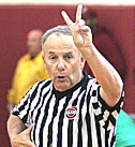2018 - 2019 SEASON
With Veteran Long Island Official Skip Yutzler
Ask The Ref !
READER QUESTIONS
JANUARY 2019
QUESTION: I am an asst coach for a local high school team (name withheld). In our last game, our opponent was making an inbounds pass from the sideline. The ball was passed to one of their guards who was clearly standing in the front court. The ball hit him in both hands (not caught) and then bounced into the back court. One of the receiver's teammates was first to the ball but the official did not call a back court violation on the play. Please explain.
ANSWER: By rule, there is "no team control" on a throw in. The ball that was inbounded cannot have "front court status" until team control exists. When the ball hit the receiver in both hands, there was still no "control" because it was never caught. "Control" wasn't established until the teammate actually caught (or, controlled) the ball in the back court. Therefore, there could be no back court violation in this situation.
To take it one step further, on a throw in, even if the receiver had jumped from the front court, caught the ball in the air and then landed in the back court, there still would be no violation because this is one of several "exceptions" to the back court rule that gives a little more allowance to the receiving team.
QUESTION: (editor's follow up) - Another play that is related to the above situation has to do with a foul by the offensive team during a throw in. Let's say that in attempting to gain position to catch an in bounds pass, guard A-2 on the offensive team shoves his defender out of his legal guarding position in order to get a better angle to receive the in bounds pass. The official calls a "team control" foul on A-2. How is this possible if (as above) there is "no team control" on a throw in?
ANSWER: This is one of the trickier aspects of a throw in because BY RULE, during a throw in, the offensive team is actually deemed to have "team control" FOR THE PURPOSES OF A FOUL CALL ONLY. This would seem to be at odds with the ruling in the play above. But it only applies to a foul by the offensive team. In this case, the foul call against the offense renders the play dead and there will be no free throws taken because (again, BY RULE) this foul is defined in the Rule Book as a "team control" foul. If there had been no foul on the play, then the offense would not be considered to be in team control during the throw in.
QUESTION: As a spectator, parent, fan and part time coach of a youth league team, it bothers me how inconsistently contact situations seem to be ruled by the officials. It appears that one man's foul is another man's no call. Please help me understand how officials are supposed to rule on contact situations.
ANSWER: The subject of "consistency" could be the subject of BOOKS, not just a simple question. But the gist of it is this. Basketball is a contact sport but it isn't football or rugby. Player safety is a primary consideration. One of the basic fundamentals of the rules is that since contact is inevitable, the officials must constantly weigh whether or not the observed contact is sufficient to cause either player (offense or defense) to gain an advantage (or place the opponent at a disadvantage) not permitted under the rules. There are many paragraphs in the Rule Book to help officials maintain player safety by defining and ruling on various contact situations. As players progress from youth leagues to Jr High to Jr Varsity to Varsity and then college play, they get stronger and are better able to play with and through contact situations. In other words, contact situations are more meaningful at the lower skill levels and often less so at the higher levels.
The best officials, over time, become expert at determining what needs to be called as a foul and what does not. This will enable the players to play in a game that has action and "flow" instead of deteriorating into an actionless, boring, whistle tooting contest that is no fun for anyone. Often times, contact that is ruled a foul on one play is deemed to be "no call" on another simply based on the effect that was observed by the officials. Unfortunately, this aspect of the rules and officiating is not well understood by too many people who then go on to label the officiating as "inconsistent." Adding to the problem is the fact that there are many situations where the observed contact is sort of "even steven" so to speak. Since both opponents are viewed as being more or less equally affected by the contact (or maybe 51/49....) the officials simply go with "no call" rather than being arbitrary and making a call that has no more merit in one direction than it does in the other. This is not an exact science and is subject to the impartiality, experience and judgment of the officials.
My best advice would be to try to see the actions of the officials in each individual contact situation as an independent event rather than trying to equate one contact situation with another similar (but rarely identical....) contact situation. Hopefully, you will come to see the logic in what the officials are calling or not calling and will see "consistency" from an official's perspective.
QUESTION: Dribbler A-1 is flying up the court being aggressively guarded by defender B-1. There are numerous possibilities in this common scenario. It could be that
1) dribbler A-1 has his head and shoulders ever so slightly ahead of his defender B-1
2) the two players are running side by side with neither player able to get ahead
3) defender B-1 is judged to be angling into the dribbler or trying to "body him up"
4) dribbler A-1 is observed to be angling into defender B-1 and may be trying to dislodge the defender in some way.
How do these situations get judged?
ANSWER: This is the essence of good officiating. The official needs to be fully mindful of which player is causing whatever to whomever. It ain't easy and the view can change in a heartbeat as the action continues. However, the official should be continually looking for advantages or disadvantages and therein lies the solution.
In situation #1, the play leans in favor of the dribbler because BY RULE any ensuing contact (after the dribbler has his head and shoulders past the defender) is the responsibility of the defender. The official will judge the play based on that fundamental. He may feel that the contact is insufficient to warrant a foul call. In fact, if the dribbler is clearly in control and unaffected by the defender's contact, it may actually hurt the dribbler to make a call and take away a good scoring opportunity.
In situation #2, it's sort of a tie.....and the official will have to be patient to see what develops.
In situation #3, if the action of defender B-1 is seen to dislodge or displace dribbler A-1, the call will go against B-1.
In situation #4, it may be that dribbler A-1 is actually putting himself at a disadvantage but clearly defender B-1 is doing nothing wrong. The official may choose to ignore this contact or, if the defender is clearly dislodged or displaced, a "player control foul" will be called against dribbler A-1.
Do you have a question?
Have you seen a play you didn't understand? Was there a controversy you'd like clarified? Send your questions in and I'll do my best to get you an answer!
Skip Yutzler
IAABO Board 127
48 Years High School and Junior College Official
Selected 5 times to officiate at the
New York State High School Championships





